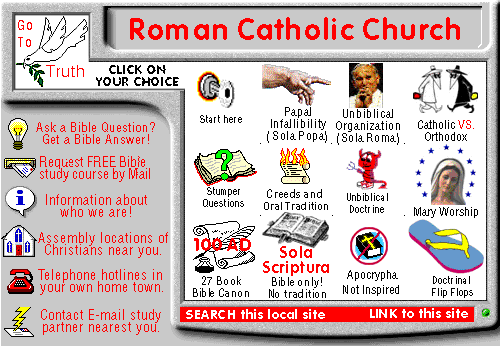Roman Catholic Doctrinal evolution: Doctrinal flip flops
Baptism: Changed from immersion to sprinkling in 1311 AD.
Baptism: Changed from immersion to sprinkling in 1311 AD.
A. Jesus was immersed not sprinkled by John the Baptist.
In those days Jesus came from Nazareth in Galilee and was baptized by John in the Jordan. Immediately coming up out of the water, He saw the heavens opening, and the Spirit like a dove descending upon Him; Mark 1:9-10
B. Bible baptism is immersion:
The word baptism in the original Greek means immersion! Our English word "baptism" is from the Greek word "baptisma" and means "immersion, submersion and emergence" (Vine's Expository Dictionary of New Testament Words, p. 96), "to dip, immerse, submerge" (Thayer's Greek-English Lexicon, p. 94).
And he ordered the chariot to stop; and they both went down into the water, Philip as well as the eunuch, and he baptized him. When they came up out of the water, the Spirit of the Lord snatched Philip away; and the eunuch no longer saw him, but went on his way rejoicing. Acts 8:38-39
C. Bible Baptism is a burial:
Only immersion fulfills the meaning of a burial, spinkling makes the idea of baptism being a burial nonsense:
"having been buried with Him in baptism, in which you were also raised up with Him through faith in the working of God, who raised Him from the dead." Colossians 2:12
"Or do you not know that all of us who have been baptized into Christ Jesus have been baptized into His death? Therefore we have been buried with Him through baptism into death, so that as Christ was raised from the dead through the glory of the Father, so we too might walk in newness of life." Romans 6:3-4
- The Orthodox church never changed and immerses to this day!
- More on baptism as immersion.
- The Apostolic Fathers always baptized by immersion.
C. The Roman Catholic church admits baptism by immersion was practiced till 1311 AD:
"Baptism took place by immersion in ancient times." (New Interpretation of the Mass, p. 120).
"Catholics admit that immersion brings out more fully the meaning of the sacrament, and that for twelve centuries it was the common practice." (Question Box, p. 240).
"Baptism used to be given by placing the person to be baptized completely in the water: it was done in this way in the Catholic Church for 1200 years." (Adult Catechism, pp. 56-57).
"The church at one time practiced immersion. This was up to the thirteenth century. The Council of Ravenna, in 1311, changed the form from immersion to pouring." (Our Faith and the Facts, p. 399).
C. Today the Roman Catholic baptizes by sprinkling and admits the change:
"How would you give baptism? I would give baptism by pouring ordinary water on the forehead of the person to be baptized..." (My Catholic Faith, p 270)
"The present mode of pouring arose from the many inconveniences connected with immersion, frequent mention of which are made in the writings of the early Church Fathers." (Question Box, p 366).
"Catholic controversialists soon proved to the Protestants that to be logical and consistent they must admit unwritten tradition. ... How could they regard infant baptism as valid, or baptism by infusion?" (Catholic Encyclopedia, Vol. XV, p. 7)
Sprinkling is Un-biblical
|

|
This is a valid baptism by full immersion.
(Left) |
|
Not even John Paul II can make right, an infant baptism by sprinkling, that is wrong according to the Bible!
(right) |

|
The Bible never changes, but Catholicism does.
By Steve Rudd

Go To Start: WWW.BIBLE.CA

![]() More Catholic doctrinal Flip-Flops
More Catholic doctrinal Flip-Flops